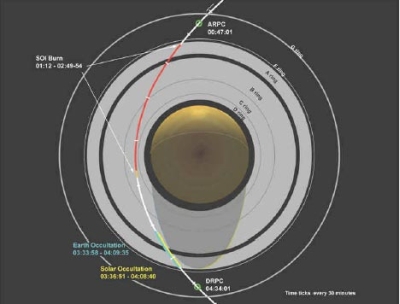Approach and Arrival at Saturn
During the rapid flyby Cassini collected spectroscopic and radar data along with images of the surface. This information can help scientists understand the composition and origin of this distant moon. The data showed evidence of an icy moon covered with darker material.
Following the flyby a trajectory correction manoeuvre was made on 16 June 2004 to place the Cassini-Huygens spacecraft on a precise intercept course with Saturn.
Arrival at Saturn
On 1 July 2004 the Cassini-Huygens spacecraft arrived at Saturn. This marked the end of the spacecraft's journey through the Solar System as well as the beginning of its tour of Saturn, its rings, moons, and magnetosphere.
During the Saturn Orbit Insertion Cassini-Huygens approached Saturn from below the ring plane. The spacecraft crossed through the large gap between the F-Ring and G-Ring. At the time Cassini-Huygens was 158 500 kilometres from Saturn's centre. This crossing occurred one hour and 52 minutes prior to the spacecraft's closest approach to Saturn.
The main engine burn began shortly after Cassini-Huygens crossed above the rings on 1 July 2004 at 01:12 UTC and ended 97 minutes later at 02:49 UTC.
 |
|
Cassini-Huygens arrival geometry. Courtesy NASA |
In order to slow the spacecraft significantly enough to be captured by Saturn's gravity, Cassini's main engine was turned to face the direction of travel. The resulting thrust from the engine acted as a braking device, slowing down the spacecraft as it entered Saturn's orbit.
Cassini-Huygens' closest approach to Saturn, during the entire four-year tour, occurred during this burn. The spacecraft's distance from Saturn was approximately 0.3 Saturn Radii (20 000 km).
Cassini-Huygens continued to coast above the rings for approximately one hour and 44 minutes before its descent back through the ring plane.
The Saturn Orbit Insertion (SOI) burn was critical to the success of the mission at Saturn. The spacecraft's close proximity to the planet and its rings provided a unique opportunity for an in-depth study of the planet, by utilizing the appropriate instruments onboard the spacecraft to conduct studies in waves, particles and imaging data.
Timetable of events
| Event Time (UT) | Earth Time (UT) | Description |
| 29 June | ||
| 20:00 | 21:24 | Begin critical commands for SOI |
| 30 June | ||
| 23:47 | 01:11 | Turn to protective attitude for ascending ring-plane crossing |
| 1 July | ||
| 00:47 | 02:11 | Ascending ring-plane crossing |
| 00:57 | 02:21 | Turn to burn altitude |
| 01:12 | 02:36 | Saturn Orbit Insertion burn start, velocity change 626 ms-1; 96 minute burn |
| 02:59 | Cassini passes behind F-ring as seen from Earth | |
| 03:06 | Cassini passes behind A-ring as seen from Earth; 25 minute communication loss likely | |
| 03:31 | Cassini passes behind Cassini division as seen from Earth | |
| 03:37 | Cassini passes behind B-ring as seen from Earth | |
| 02:30 | 03:54 | Saturn orbit achieved; spacecraft is slowed to enable capture by Saturn gravity (78 minutes into burn) |
| 02:39 | 04:03 | Closest approach to Saturn, distance 80 230 km from centre of Saturn, 19 980 km from cloud tops |
| 02:41 | 04:05 | Cassini passes behind C-ring as seen from Earth |
| 02:48 | 04:12 | Saturn Orbit Insertion nominal burn end |
| 02:54 | 04:18 | Spacecraft on Earth pointing |
| 02:57 | 04:21 | Nominal end of critical sequence |
| 03:06 | 04:30 | Switch to HGA |
| 04:57 | Cassini passes behind Saturn as seen from Earth | |
| 04:08 | 05:32 | Turn to protective attitude for descending ring-plane crossing |
| 05:33 | Cassini emerges from behind Saturn | |
| 05:44 | Cassini emerges from behind A-ring | |
| 04:34 | 05:58 | Descending ring-plane crossing |
| 05:36 | 07:00 | Spacecraft returns to Earth pointing; SOI data playback begins |
| 11:15 | 12:39 | First SOI image returned |
| 2 July | ||
| 09:30 | 10:54 | Closest approach to Titan; distance 339 000 km, phase angle 67 degrees |
| 17:51 | 19:15 | Titan playback starts |
Note:
The first column indicates the absolute time (in Universal Time) at which the event happened. The second column indicates the time the event was recorded on Earth. There is an 84 minute difference between the actual event time and the recorded event time due to the distance between the Earth and Saturn.
